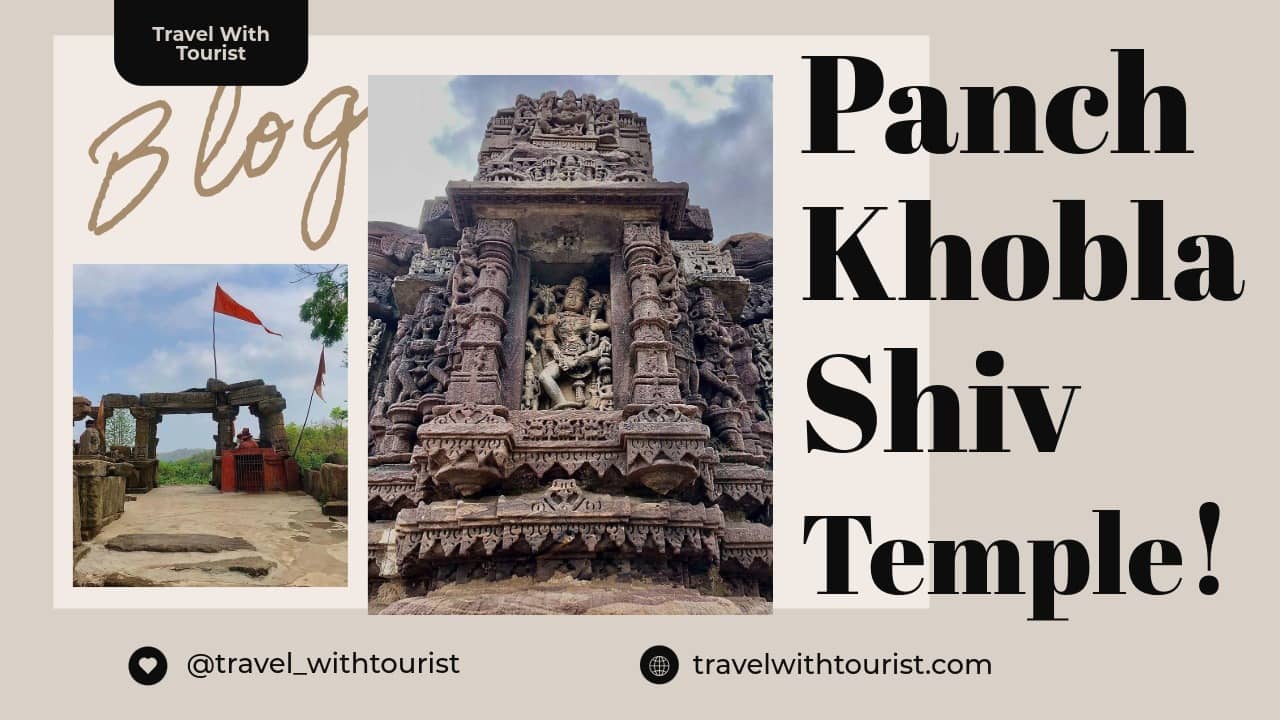Nestled in the quiet embrace of rural Gujarat, Panch Khobla Shiv Mandir (also known as Neelkanth Mahadev Temple) stands as a profound testament to ancient devotion and architectural brilliance.
This 13th-century Shaivite shrine, overlooking a tranquil lake, invites weary souls to pause, reflect, and reconnect with nature’s quiet rhythm.
Far from the crowds of mainstream tourist spots, it’s a sanctuary where intricate stone carvings whisper stories of a bygone era, and the gentle lapping of water against the shore soothes the spirit.
If you’re seeking a day trip from Vadodara that blends spirituality, history, and raw natural beauty, this hidden gem in Panchmahal District is calling your name.

Panch Khobla Shiv Mandir overlooking the serene lake, with its ancient stone structure framed by lush greenery.
A Glimpse into History: The Legacy of Devotion
Constructed in 1274 CE during the Chudasama Dynasty—a Rajput clan known for their patronage of Hindu architecture—this temple embodies the golden age of medieval Gujarati temple-building.
Though partially ruined over centuries, its majestic form endures, earning it a status as an informal archaeological site.
Dedicated to Lord Shiva (Mahadev), the temple’s name “Panch Khobla” may evoke the “five lobes” or natural contours of the surrounding landscape, adding a poetic layer to its lore.
The site’s spiritual significance lies in its unpretentious aura: no grand festivals dominate, but locals and pilgrims visit for quiet darshan (worship) and to seek solace.
Legends tie it to broader Shaivite traditions, where Shiva’s form as Neelkanth (blue-throated one) symbolizes protection from poison—much like how this temple shields visitors from the chaos of modern life.
It’s not just a place of prayer; it’s a portal to introspection, where the mind finds clarity amid the echoes of history.
How to Reach Panch Khobla Shiv Mandir
Reaching this offbeat treasure is straightforward, making it ideal for a half-day excursion from nearby cities.
- By Road (Recommended): From Vadodara (Baroda), it’s a scenic 55 km drive (about 1-1.5 hours) via NH48 towards Halol.
Head to Tadia Dam first—Google Maps pin: Tadia Dam—and turn left at the village signboard for Panch Khobla.
The temple is right opposite the lake; park nearby and stroll in. Roads are mostly paved, but expect rural bumps—opt for a sturdy vehicle or auto-rickshaw from Halol town (15 km away). - By Train/Bus: Nearest railhead is Vadodara Junction (55 km). From there, take a state bus to Halol, then a local auto or shared jeep (₹200-300 round trip).
Buses run frequently from Vadodara’s central depot. - By Air: Vadodara Airport (BDQ) is 60 km away; taxis cost ₹1,500-2,000 one-way.
No public transport directly to the village, so self-drive or cabs via apps like Ola/Uber work best. Coordinates for easy navigation: 22.677°N, 73.467°E. Temple pin: Panch Khobla Mahadev Temple.
What to See and Do: Immersing in Tranquility
The temple’s charm unfolds slowly, rewarding patient explorers with layers of beauty.
- The Main Shrine: Step into a world of exquisite stonework.
The facade boasts mind-blowing carvings of deities, mythical scenes, and floral motifs—hallmarks of Solanki-influenced architecture.
Inside, the sanctum houses a simple yet potent Shiva Lingam, where the air feels charged with devotion. Benches line the lakefront, perfect for meditation as the sun dips low. - Architectural Highlights: Marvel at the sculpted panels depicting Shiva’s cosmic dance (Tandava) and attendant figures like Ganesha and Parvati.
The dome, though weathered, retains its geometric elegance, with friezes that rival those in Modhera Sun Temple. - Lake Views and Nature Trails: The adjacent lake mirrors the temple’s silhouette, creating postcard-worthy vistas. Wander short trails along the water’s edge or hug ancient trees—yes, it’s a tree-hugger’s paradise!
Early mornings bring mist-shrouded sunrises; evenings, a symphony of birdsong.
Activities are low-key: photography, birdwatching, or simply sitting in silence.
No guided tours, but the site’s intimacy makes self-exploration magical. Allow 1-2 hours here.

safarwithsasha.com
Detailed close-up of the temple’s intricate carvings, showcasing Shiva and mythical figures in stone.
Nearby Attractions: A Full-Day Itinerary
Pair your visit with these gems for a holistic escape:
| Attraction | Distance from Temple | Highlights | Time Needed |
|---|---|---|---|
| Tadia Dam | 2 km | Scenic reservoir with walking bridges, hill climbs, and sunrise spots. A “little brother” to the larger Dev Dam—perfect for picnics. | 1-2 hours |
| Panch Khobla Hanuman Temple | 1 km | Ancient shrine at road’s end; calming vibes with basic carvings. Park and walk the final stretch. Pin: Hanumanji Temple. | 30-45 mins |
| Champaner-Pavagadh Archaeological Park | 25 km | UNESCO site with forts, mosques, and hikes. A deeper dive into Gujarat’s medieval past. | Half-day |
| Ancient Mahadev Temple, Desar, Halol | 3.5 km | Old Ancient Mahadev Temple | 1 hour |
Start at Tadia Dam for dawn, hit the Shiv Mandir mid-morning, and end at Hanuman Temple—pure bliss!

safarwithsasha.com
The temple entrance with saffron flags fluttering against a backdrop of verdant hills.
Best Time to Visit and Essential Tips
- Ideal Season: October to March for mild weather (15-25°C). Monsoons (July-September) transform the area into a lush paradise but make trails slippery. Avoid peak summer (April-June) due to heat.
- Timings: Open sunrise to sunset (no fixed hours; it’s an open site). Best at dawn or dusk for ethereal light.
- Entry and Costs: Free entry. Minimal facilities-carry water, snacks, and insect repellent. No restrooms on-site; use those at Tadia Dam.
- Tips for Travelers:
- Dress modestly (cover shoulders/knees) out of respect.
- Hire a local guide in Halol (₹500/day) for historical insights.
- Eco-friendly: Leave no trace; support villagers by buying local honey or herbs.
- Safety: Roads are safe, but watch for wildlife near the lake. Women travelers: Visit in groups.
- Accessibility: Uneven terrain; not wheelchair-friendly.
Here, that melody is the wind through ancient stones and the heartbeat of untouched nature.
Whether you’re a history buff, spiritual seeker, or nature lover, Panch Khobla Shiv Mandir promises a reset for the soul.
Pack your journal, breathe deep, and let Gujarat’s quiet corners heal you. Share your journey—tag #PanchKhoblaShivMandir—and inspire others to slow down.
Sources: Insights drawn from traveler accounts on Safar with Sasha, Tripoto, and social media explorations.



